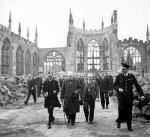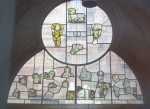The West Midlands city of Coventry was a prosperous town during the Middle Ages, a major center of the textile trade, and by the 14th century the fourth largest city in England. It had two churches, the 12th century cathedral in St. Mary’s Priory, which was destroyed in Henry VIII’s dissolution of the monasteries in 1539, and St. Michael’s, a 14th century Gothic church that was the largest parish church in the country. The guilds saw to it that St. Michael’s was packed with top quality stained glass by artists like John Thornton, the master glazier who created York Minster’s Great East Window.
 After St. Mary’s was demolished — the only cathedral to suffer this fate during the Reformation — Coventry was absorbed into the nearby Lichfield diocese. In 1918, the new diocese of Coventry was created and since the city already had a large, dramatic church in St. Michael’s, it became the new Coventry Cathedral.
After St. Mary’s was demolished — the only cathedral to suffer this fate during the Reformation — Coventry was absorbed into the nearby Lichfield diocese. In 1918, the new diocese of Coventry was created and since the city already had a large, dramatic church in St. Michael’s, it became the new Coventry Cathedral.
Just over 20 years later, in 1939, with World War II looming on the horizon, the stained glass panels were removed from the cathedral windows as a precaution to prevent their destruction in any German bombing raids. Coventry was replete with industrial targets both civil and military, so there was little doubt that it would see action. The glass was packed into 30 crates and stored in the cellar of the rectory in the small village of Hampton Lucy.
 Coventry was bombed a number of times in the early days of the war, but the targets were primarily military and industrial. The damage to the historic center and loss of life were small. On the evening of November 14, 1940, German bombers dropped high explosive bombs on the city’s utilities and roads. Once the water was knocked out and the roads were impassable from bomb craters, the next wave of German planes dropped explosive and incendiary bombs with the express purpose of starting fires that fire brigades could not contain thanks to the damaged water mains and cratered roads.
Coventry was bombed a number of times in the early days of the war, but the targets were primarily military and industrial. The damage to the historic center and loss of life were small. On the evening of November 14, 1940, German bombers dropped high explosive bombs on the city’s utilities and roads. Once the water was knocked out and the roads were impassable from bomb craters, the next wave of German planes dropped explosive and incendiary bombs with the express purpose of starting fires that fire brigades could not contain thanks to the damaged water mains and cratered roads.
Coventry Cathedral suffered multiple direct hits. Firefighters were able to put out the first fire of the evening, but as the bombing progressed that night, the fires became impossible to contain. By the time the all-clear sirens rang the next morning, there was nothing left of Coventry Cathedral but smoldering ruins. A few walls and the tall spire were all that remained. Those ruins are still on the spot. A new cathedral was built in Modernist style right next to it, with the ruins as a consecrated garden space dedicated to peace and reflection. The foundation stone was laid by Queen Elizabeth II in 1956 and the new church was consecrated in 1962.
 Meanwhile, in 1957 the little rectory in Hampton Lucy was sold. The crates full of medieval stained glass had remained unharmed in the cellar for almost 20 years, but with the sale they were returned to Coventry. The architect of the new cathedral, Sir Basil Spence, wanted to incorporate some of this glass into the new building in some way. Putting together whole windows wasn’t going to happen because most of the panes had been removed and crated without any annotation of their original arrangement. Instead, Spence and his team selected a few choice pieces and in 1965 installed them in a small chapel in the south porch of the old cathedral ruins known today as Haigh Chapel.
Meanwhile, in 1957 the little rectory in Hampton Lucy was sold. The crates full of medieval stained glass had remained unharmed in the cellar for almost 20 years, but with the sale they were returned to Coventry. The architect of the new cathedral, Sir Basil Spence, wanted to incorporate some of this glass into the new building in some way. Putting together whole windows wasn’t going to happen because most of the panes had been removed and crated without any annotation of their original arrangement. Instead, Spence and his team selected a few choice pieces and in 1965 installed them in a small chapel in the south porch of the old cathedral ruins known today as Haigh Chapel.
Since then, other panes have been integrated into the new cathedral, including mosaic-style combinations that had been put together during 19th century modifications to the church. Around 5,000 pieces of stained glass were still in storage.
 Thanks to a joint fundraising project by World Monuments Fund Britain and Coventry Cathedral that raised £250,000 ($388,000), conservators will begin work on the medieval stained glass of Coventry Cathedral this summer, and best of all, they’ll be doing it in public. The Faces in the Glass Live exhibit at Herbert Art Gallery & Museum will run from August 6th through October 31st. Admission is free, and visitors will be able to watch the conservators as they clean the panes, meet them, and interact with them. Every Thursday at 3:00 conservators will give a 30 minute talk about the glass and their work.
Thanks to a joint fundraising project by World Monuments Fund Britain and Coventry Cathedral that raised £250,000 ($388,000), conservators will begin work on the medieval stained glass of Coventry Cathedral this summer, and best of all, they’ll be doing it in public. The Faces in the Glass Live exhibit at Herbert Art Gallery & Museum will run from August 6th through October 31st. Admission is free, and visitors will be able to watch the conservators as they clean the panes, meet them, and interact with them. Every Thursday at 3:00 conservators will give a 30 minute talk about the glass and their work.
The stored glass is currently catalogued by color and subject, but there is hope that they might be recomposed into their original medieval configurations thanks to a piece of software originally designed to piece together shredded Cold War documents.
Ian Crick-Smith, a researcher at the University of Lincoln, says that renderings of the broken edges of the glass will be created using two- or three-dimensional laser scanning, and that software will then be used to suggest best matches and alignment. “There is definitely a growth area for digital technology in the heritage investigation sector,” he says. Similar technology was used by Princeton University to help reconstruct fragments from ancient frescoes at Akrotiri.
The software was developed after the fall of the Iron Curtain, when it was used to recreate documents that had been destroyed by shredding and tearing. “It has also been used to reassemble damaged works of art on paper,” Crick-Smith says. “We don’t know of any other instance where this has been used for stained glass.” The composition of the glass and Thornton’s production system are also being explored.
The ultimate plan is to create a display area for a selection of the pieces in the crypts underneath the ruins of the old cathedral. Other panes might be used to make contemporary art installations in the new cathedral.
For more on the history of the stained glass windows of Coventry Cathedral, read this excellent article. To explore the ruins and the new cathedral, see these QuickTime panoramas.